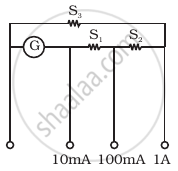Advertisements
Advertisements
प्रश्न
Draw a labelled diagram of a moving coil galvanometer. Describe briefly its principle and working.
उत्तर
Principle:
Its working is based on the fact that when a current carrying coil is placed in a magnetic field, it experiences a torque.

Working:
Suppose the coil PQRS is suspended freely in the magnetic field.
Let l = length PQ or RS of the coil
b = breadth QR or SP of the coil
n = number of turns in the coil
Area of each turn of the coil, A = l × b
Let B = strength of the magnetic field in which the coil is suspended
I = current passing through the coil in the direction PQRS
At any instant, let α be the angle that the normal drawn on the plane of the coil makes with the direction of magnetic field.
The rectangular coil carrying current, when placed in the magnetic field, experiences a torque whose magnitude is given by:
τ = nIBA sinα
Due to the deflecting torque, the coil rotates and the suspension wire gets twisted. A restoring torque is set up in the suspension wire.
Let θ be the twist produced in the phosphor bronze strip due to the rotation of the coil and K be the restoring torque per unit twist of the phosphor bronze strip. Then, we have:
Total restoring torque produced = kθ
In equilibrium position of the coil, we have:
Deflecting torque = Restoring torque
∴ NIBA = kθ
or
`I=k/(NBA)theta " or "Gtheta`
Here,
`K/(NBA)=G=a["constant for a galvanometer"]`
It is known as galvanometer constant.
APPEARS IN
संबंधित प्रश्न
The combined resistance of a galvanometer of resistance 500Ω and its shunt is 21Ω. Calculate the value of shunt.
A rectangular coil of a moving coil galvanometer contains 100 turns, each having area
15 cm2. It is suspended in the radial magnetic field 0.03 T. The twist constant of suspension
fibre is 15 x 10-10 N-m/degree. Calculate the sensitivity of the moving coil galvanometer.
With the help of a neat and labelled diagram, explain the principle and working of a moving coil galvanometer ?
Explain, giving reasons, the basic difference in converting a galvanometer into (i) a voltmeter and (ii) an ammeter?
The deflection in a moving coil galvanometer is ______.
The coil of galvanometer consists of 100 turns and effective area of 1 square cm. The restoring couple is 10-8 N-m/rad. The magnetic field between the pole pieces is 5T. The current sensitivity of this galvanometer will be ______.
A multirange current meter can be constructed by using a galvanometer circuit as shown in figure. We want a current meter that can measure 10 mA, 100 mA and 1A using a galvanometer of resistance 10 Ω and that prduces maximum deflection for current of 1mA. Find S1, S2 and S3 that have to be used

Explain in brief the basic construction of a moving-coil table galvanometer whit a neat labelled diagram.
A resistance of 3Ω is connected in parallel to a galvanometer of resistance 297Ω. Find the fraction of current passing through the galvanometer.
A voltmeter has a range of 0 - 20 V and a resistance of 500 Q. Explain how can be used to measure voltages from 0 - 200 volt?
